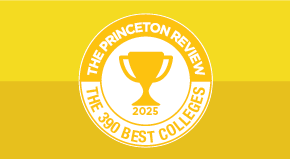Preparing for the SAT can seem daunting. Unlike standard school exams, which are based on material that you have recently learned, the SAT tests content from multiple years of school. And in terms of testing format, most questions on the SAT are multiple-choice, meaning that there’s no partial credit for strong reasoning or nearly complete work. (The handful of questions that are not multiple choice don’t allow for partial credit either.) Also, there is more time pressure than you’re probably used to, and you may struggle to finish everything before the clock expires.

Thankfully, there’s a lot you can do to make the process less overwhelming. First, take a deep breath and remember that the SAT is just one of the factors that a college will look at when considering your application. Second, with the proper preparation—like The Princeton Review’s Digital SAT 1400+ Course, your score can be improved. And The Princeton Review has been helping students succeed on the SAT for over 40 years; now it’s your turn.
Step 1: Plan Ahead
It is important to give yourself sufficient preparation time to get your best possible score on the SAT. Most students take between 4 and 12 weeks to prepare, but the exact amount of time depends on your starting scores and your goals. During this time, you’ll want to put at least 30 minutes a day into your preparation. Think of SAT prep as a workout for the brain, and just like physical exercise, you want to make it a part of your regular routine so that you can maintain the good skills and habits that you develop along the way. In addition, it’s a good idea to give yourself at least four two-and-half-hour blocks of time in which you can take full-length practice tests as needed. This will help you gauge your progress and determine where you need to focus your preparation moving forward. Also, taking these tests will help you get acclimated to the testing experience and help build the endurance you’ll need for the real test.
You’ll also need to choose an initial test date, ideally one that leaves you enough time to schedule a second (or even third) test date if necessary. When you do choose a date, it’s important to consider your schedule, specifically your schedule in the 4 to 12 weeks before each possible test date. If you have significant time commitments that will be pulling your focus elsewhere (such as multiple after-school activities), you’ll either need to find time when you’re going to be more available or cut back on your least pressing current obligations to free up the time you need to focus on your SAT prep.
It is also important to plan to take the SAT at least twice, maybe three times. While The Princeton Review recommends that you come to your first test as prepared as possible, it’s very common to fall short of your goal score on attempt number one, and that’s okay. That’s where having another chance comes in handy. Furthermore, life happens. There’s always the possibility that you’ll get sick or have some other unexpected emergency that causes you to miss your scheduled test. If you plan ahead and schedule your first test early enough (but not so early that you’re unprepared), you give yourself enough time to schedule additional tests if necessary.
While you can take the SAT early, there is certain math content on the Digital SAT that you likely won’t encounter until junior year (11th grade). Therefore, for most students, taking the SAT prior to junior year is not ideal. If you are in advanced classes and are considering taking the SAT prior to junior year, be sure to start off with a practice test to gauge whether you have a sufficient background to take the test now, or whether it’s best to wait.
It is crucial to take the SAT prior to application deadlines. For some students, the key deadline is November 1st of their senior year (12th grade). This date is the application deadline for Early Decision and Early Action in many schools. While these options are not appropriate for everyone, it’s best to leave these as options by taking the SAT well in advance of November of senior year. If you know for sure that you won’t be applying through Early Decision or Early Action, take careful note of the deadlines for the schools that you are applying to. Research schools (The Princeton Review has a wonderful tool available) and plan your application season so that you can get ahead of any deadlines.
Step 2: Take a Practice Test
A lot of what appears on the SAT will be material that you’ve learned in high school, but not all of it. (How often do you work on reading comprehension or multiple-choice grammar in your high school English classes?) Also, there are some unique elements to the timing and format of the Digital SAT that will almost certainly be different from the tests you’re used to taking. With all that in mind, the best way to know where you stand is to first take a practice test.
The Princeton Review offers a free practice test on its website. This test emulates all the features of the Digital SAT, such as highlighting, computer-adaptive scoring, and a built-in calculator, so you’ll get a great introduction to the testing experience.
To get the most out of your practice test, do your best to emulate a real testing environment. Avoid distractions: ask others in your home to leave you alone or go abscond to a library or other quiet place to take the test. Also, make sure to stick to the correct timing for each part of the test, including the breaks. (Seriously, take the breaks, both while practicing and on test day.) This will give you the most accurate measure possible of where you stand at this point in your preparation and give you the best practice, not just for the test content, but for the testing experience.
After the test, spend some time reviewing The Princeton Review’s score report, which breaks down your results into areas of strengths and areas in need of improvement. Each question has a thorough explanation, which allows you to use questions you got incorrect or struggled with as learning opportunities. This will also help you determine what to focus on studying next.
Step 3: Determine How to Prepare
Depending on your circumstances, including your starting score, your goals, and your time availability, you can decide on one of the many options available for your preparation needs, such as:
- Books: Self-study books are great if you are an independent worker who wants control over when and where you prepare. Digital SAT Premium Prep, 645+ Practice Questions, and other books by The Princeton Review and published by Penguin Random House are available where books are sold.
- Self-Paced Course: If you’re a self-driven student who is looking for a bit more guidance and a more online experience, The Princeton Review’s self-paced course provides a recommendation engine that will guide you through the video lessons and drills to help you meet your goals on your schedule.
- Teacher-Led Courses: If you want more guidance and enjoy working with other students, The Princeton Review offers courses both online and in-person (at select locations). Our teachers go through a rigorous training process, ensuring that each class is led by a certified SAT expert. You’ll also gain access to online materials as well as exclusive books used only in our courses and tutoring.
- Private Tutoring: For some, working one-on-one with a tutor provides the best results. Tutors can assess your strengths and weaknesses, making for an efficient preparation process. Furthermore, The Princeton Review can match you with a tutor that can meet your busy schedule.
The Princeton Review’s Enrollment Advisors are available at 1-800-273-8439 to discuss your situation and help you determine the best approach for you to achieve your dream scores.
Step 4: Take the Test
After all your work preparing, it’s important to have a plan for the day of the SAT. Be sure to get enough rest, exercise or meditate to help you focus, and eat a balanced meal so you can position yourself to score as well as you know you can.
The more you prepare, the more prepared you’ll be not just for the test but for the results, and that will help you stay calm, flexible, and ready for whatever you may still need to do to reach your SAT goals.
Explore Colleges For You
Connect with our featured colleges to find schools that both match your interests and are looking for students like you.
Get Started on Athletic Scholarships & Recruiting!
Join athletes who were discovered, recruited & often received scholarships after connecting with NCSA's 42,000 strong network of coaches.
Best 390 Colleges
168,000 students rate everything from their professors to their campus social scene.
Explore Colleges For You
Connect with our featured colleges to find schools that both match your interests and are looking for students like you.
Get Started on Athletic Scholarships & Recruiting!
Join athletes who were discovered, recruited & often received scholarships after connecting with NCSA's 42,000 strong network of coaches.
Best 390 Colleges
168,000 students rate everything from their professors to their campus social scene.
Explore Colleges For You
Connect with our featured colleges to find schools that both match your interests and are looking for students like you.
Get Started on Athletic Scholarships & Recruiting!
Join athletes who were discovered, recruited & often received scholarships after connecting with NCSA's 42,000 strong network of coaches.
Best 390 Colleges
168,000 students rate everything from their professors to their campus social scene.



